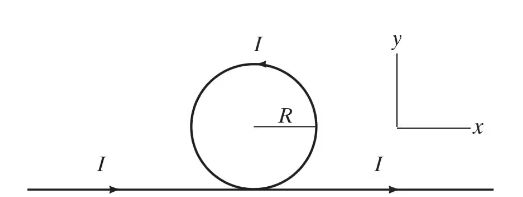A set of Helmholtz coils (see Problem 62, Fig. 28–61) have a radius R = 10.0 cm and are separated by a distance R = 10.0 cm. Each coil has 85 loops carrying a current I = 2.0 A. By what % does B vary from 𝓍 = 5.0 cm to 𝓍 = 6.0 cm?
Table of contents
- 0. Math Review31m
- 1. Intro to Physics Units1h 29m
- 2. 1D Motion / Kinematics3h 56m
- Vectors, Scalars, & Displacement13m
- Average Velocity32m
- Intro to Acceleration7m
- Position-Time Graphs & Velocity26m
- Conceptual Problems with Position-Time Graphs22m
- Velocity-Time Graphs & Acceleration5m
- Calculating Displacement from Velocity-Time Graphs15m
- Conceptual Problems with Velocity-Time Graphs10m
- Calculating Change in Velocity from Acceleration-Time Graphs10m
- Graphing Position, Velocity, and Acceleration Graphs11m
- Kinematics Equations37m
- Vertical Motion and Free Fall19m
- Catch/Overtake Problems23m
- 3. Vectors2h 43m
- Review of Vectors vs. Scalars1m
- Introduction to Vectors7m
- Adding Vectors Graphically22m
- Vector Composition & Decomposition11m
- Adding Vectors by Components13m
- Trig Review24m
- Unit Vectors15m
- Introduction to Dot Product (Scalar Product)12m
- Calculating Dot Product Using Components12m
- Intro to Cross Product (Vector Product)23m
- Calculating Cross Product Using Components17m
- 4. 2D Kinematics1h 42m
- 5. Projectile Motion3h 6m
- 6. Intro to Forces (Dynamics)3h 22m
- 7. Friction, Inclines, Systems2h 44m
- 8. Centripetal Forces & Gravitation7h 26m
- Uniform Circular Motion7m
- Period and Frequency in Uniform Circular Motion20m
- Centripetal Forces15m
- Vertical Centripetal Forces10m
- Flat Curves9m
- Banked Curves10m
- Newton's Law of Gravity30m
- Gravitational Forces in 2D25m
- Acceleration Due to Gravity13m
- Satellite Motion: Intro5m
- Satellite Motion: Speed & Period35m
- Geosynchronous Orbits15m
- Overview of Kepler's Laws5m
- Kepler's First Law11m
- Kepler's Third Law16m
- Kepler's Third Law for Elliptical Orbits15m
- Gravitational Potential Energy21m
- Gravitational Potential Energy for Systems of Masses17m
- Escape Velocity21m
- Energy of Circular Orbits23m
- Energy of Elliptical Orbits36m
- Black Holes16m
- Gravitational Force Inside the Earth13m
- Mass Distribution with Calculus45m
- 9. Work & Energy1h 59m
- 10. Conservation of Energy2h 54m
- Intro to Energy Types3m
- Gravitational Potential Energy10m
- Intro to Conservation of Energy32m
- Energy with Non-Conservative Forces20m
- Springs & Elastic Potential Energy19m
- Solving Projectile Motion Using Energy13m
- Motion Along Curved Paths4m
- Rollercoaster Problems13m
- Pendulum Problems13m
- Energy in Connected Objects (Systems)24m
- Force & Potential Energy18m
- 11. Momentum & Impulse3h 40m
- Intro to Momentum11m
- Intro to Impulse14m
- Impulse with Variable Forces12m
- Intro to Conservation of Momentum17m
- Push-Away Problems19m
- Types of Collisions4m
- Completely Inelastic Collisions28m
- Adding Mass to a Moving System8m
- Collisions & Motion (Momentum & Energy)26m
- Ballistic Pendulum14m
- Collisions with Springs13m
- Elastic Collisions24m
- How to Identify the Type of Collision9m
- Intro to Center of Mass15m
- 12. Rotational Kinematics2h 59m
- 13. Rotational Inertia & Energy7h 4m
- More Conservation of Energy Problems54m
- Conservation of Energy in Rolling Motion45m
- Parallel Axis Theorem13m
- Intro to Moment of Inertia28m
- Moment of Inertia via Integration18m
- Moment of Inertia of Systems23m
- Moment of Inertia & Mass Distribution10m
- Intro to Rotational Kinetic Energy16m
- Energy of Rolling Motion18m
- Types of Motion & Energy24m
- Conservation of Energy with Rotation35m
- Torque with Kinematic Equations56m
- Rotational Dynamics with Two Motions50m
- Rotational Dynamics of Rolling Motion27m
- 14. Torque & Rotational Dynamics2h 5m
- 15. Rotational Equilibrium3h 39m
- 16. Angular Momentum3h 6m
- Opening/Closing Arms on Rotating Stool18m
- Conservation of Angular Momentum46m
- Angular Momentum & Newton's Second Law10m
- Intro to Angular Collisions15m
- Jumping Into/Out of Moving Disc23m
- Spinning on String of Variable Length20m
- Angular Collisions with Linear Motion8m
- Intro to Angular Momentum15m
- Angular Momentum of a Point Mass21m
- Angular Momentum of Objects in Linear Motion7m
- 17. Periodic Motion2h 9m
- 18. Waves & Sound3h 40m
- Intro to Waves11m
- Velocity of Transverse Waves21m
- Velocity of Longitudinal Waves11m
- Wave Functions31m
- Phase Constant14m
- Average Power of Waves on Strings10m
- Wave Intensity19m
- Sound Intensity13m
- Wave Interference8m
- Superposition of Wave Functions3m
- Standing Waves30m
- Standing Wave Functions14m
- Standing Sound Waves12m
- Beats8m
- The Doppler Effect7m
- 19. Fluid Mechanics4h 27m
- 20. Heat and Temperature3h 7m
- Temperature16m
- Linear Thermal Expansion14m
- Volume Thermal Expansion14m
- Moles and Avogadro's Number14m
- Specific Heat & Temperature Changes12m
- Latent Heat & Phase Changes16m
- Intro to Calorimetry21m
- Calorimetry with Temperature and Phase Changes15m
- Advanced Calorimetry: Equilibrium Temperature with Phase Changes9m
- Phase Diagrams, Triple Points and Critical Points6m
- Heat Transfer44m
- 21. Kinetic Theory of Ideal Gases1h 50m
- 22. The First Law of Thermodynamics1h 26m
- 23. The Second Law of Thermodynamics3h 11m
- 24. Electric Force & Field; Gauss' Law3h 42m
- 25. Electric Potential1h 51m
- 26. Capacitors & Dielectrics2h 2m
- 27. Resistors & DC Circuits3h 8m
- 28. Magnetic Fields and Forces2h 23m
- 29. Sources of Magnetic Field2h 30m
- Magnetic Field Produced by Moving Charges10m
- Magnetic Field Produced by Straight Currents27m
- Magnetic Force Between Parallel Currents12m
- Magnetic Force Between Two Moving Charges9m
- Magnetic Field Produced by Loops andSolenoids42m
- Toroidal Solenoids aka Toroids12m
- Biot-Savart Law (Calculus)18m
- Ampere's Law (Calculus)17m
- 30. Induction and Inductance3h 38m
- 31. Alternating Current2h 37m
- Alternating Voltages and Currents18m
- RMS Current and Voltage9m
- Phasors20m
- Resistors in AC Circuits9m
- Phasors for Resistors7m
- Capacitors in AC Circuits16m
- Phasors for Capacitors8m
- Inductors in AC Circuits13m
- Phasors for Inductors7m
- Impedance in AC Circuits18m
- Series LRC Circuits11m
- Resonance in Series LRC Circuits10m
- Power in AC Circuits5m
- 32. Electromagnetic Waves2h 14m
- 33. Geometric Optics2h 57m
- 34. Wave Optics1h 15m
- 35. Special Relativity2h 10m
29. Sources of Magnetic Field
Magnetic Field Produced by Loops andSolenoids
Problem 79
Textbook Question
Part of a long, thin insulated straight wire is formed into a single circular loop of radius 𝑅 (Fig. 28–68) and carries a current I. (a) What is the magnitude and direction of the magnetic field at the center of the loop? (b) If the plane of the loop is twisted 90 degrees so that the plane is perpendicular to the straight part of the wire (i.e., in the yz plane) what is the magnitude and direction of the field now at the center of the loop?

 Verified step by step guidance
Verified step by step guidance1
Step 1: Understand the problem and identify the relevant concepts. The problem involves calculating the magnetic field at the center of a circular loop of wire carrying current I. This requires using the Biot-Savart law or Ampere's law for part (a). For part (b), the orientation of the loop changes, and we need to analyze the new configuration to determine the magnetic field.
Step 2: For part (a), recall the formula for the magnetic field at the center of a circular loop carrying current I. The magnitude of the magnetic field is given by: , where is the permeability of free space, I is the current, and R is the radius of the loop. The direction of the magnetic field can be determined using the right-hand rule.
Step 3: For part (b), when the plane of the loop is twisted 90 degrees, the loop is now perpendicular to the straight wire. The magnetic field at the center of the loop will be influenced by both the loop and the straight wire. Analyze the contributions from each component separately. The straight wire produces a magnetic field at the center of the loop, which can be calculated using the Biot-Savart law or Ampere's law.
Step 4: Combine the magnetic field contributions from the loop and the straight wire for part (b). The magnetic field from the loop remains the same in magnitude but changes direction due to the new orientation. The magnetic field from the straight wire depends on the distance from the wire to the center of the loop and follows the formula: , where r is the distance from the wire to the point of interest.
Step 5: Use vector addition to determine the net magnetic field at the center of the loop for part (b). Since the magnetic fields from the loop and the straight wire are perpendicular to each other, their magnitudes can be combined using the Pythagorean theorem: . The direction of the net field can be determined by considering the vector components.
 Verified video answer for a similar problem:
Verified video answer for a similar problem:This video solution was recommended by our tutors as helpful for the problem above
Video duration:
9mPlay a video:
Was this helpful?
Key Concepts
Here are the essential concepts you must grasp in order to answer the question correctly.
Magnetic Field Due to a Current Loop
The magnetic field at the center of a circular loop carrying a current can be determined using the Biot-Savart Law. The magnitude of the magnetic field (B) at the center is given by the formula B = (μ₀I)/(2R), where μ₀ is the permeability of free space, I is the current, and R is the radius of the loop. The direction of the magnetic field follows the right-hand rule, where the thumb points in the direction of the current, and the curled fingers indicate the direction of the magnetic field.
Recommended video:
Guided course

Magnetic Field Produced by Loops and Solenoids
Right-Hand Rule
The right-hand rule is a mnemonic used to determine the direction of the magnetic field around a current-carrying conductor. For a straight wire, if you point your thumb in the direction of the current, your fingers will curl in the direction of the magnetic field lines. This rule is essential for visualizing how the magnetic field orientation changes when the configuration of the current-carrying wire is altered, such as twisting the loop.
Recommended video:
Guided course

Force on Moving Charges & Right Hand Rule
Effect of Loop Orientation on Magnetic Field
The orientation of a current-carrying loop affects the direction of the magnetic field it produces. When the plane of the loop is twisted, the magnetic field direction can change significantly. For instance, if the loop is oriented perpendicular to the straight wire, the magnetic field at the center will still be determined by the right-hand rule, but its direction will be different compared to when the loop is in the original plane.
Recommended video:
Guided course

Magnetic Field Produced by Loops and Solenoids

 13:54m
13:54mWatch next
Master Magnetic Field Produced by Loops and Solenoids with a bite sized video explanation from Patrick
Start learningRelated Videos
Related Practice
Textbook Question
357
views
